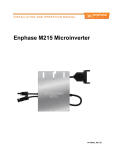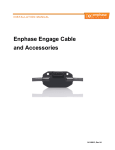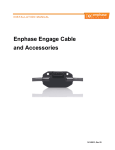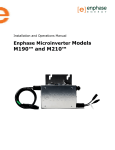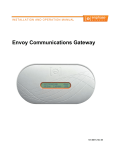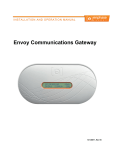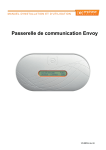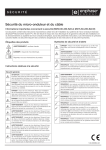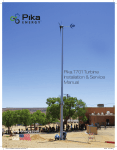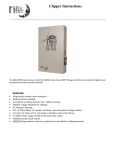Download Mustang M250/S Technical data
Transcript
I NS TA L L A TI O N A N D O P E R A TI O N MA NU A L Enphase M250 Microinverter with integrated ground—no GEC required 141-00022, Rev 01 M250 Installation and Operation Contact Information Enphase Energy Inc. 1420 N. McDowell Blvd. Petaluma, CA 94954 http://www.enphase.com [email protected] [email protected] FCC Compliance This equipment has been tested and found to comply with the limits for a Class B digital device, pursuant to part 15 of the FCC Rules. These limits are designed to provide reasonable protection against harmful interference in a residential installation. This equipment generates, uses and can radiate radio frequency energy and, if not installed and used in accordance with the instructions, may cause harmful interference to radio communications. However, there is no guarantee that interference will not occur in a particular installation. If this equipment does cause harmful interference to radio or television reception, which can be determined by turning the equipment off and on, you are encouraged to try to correct the interference by one or more of the following measures: Reorient or relocate the receiving antenna. Increase the separation between the equipment and the receiver. Connect the equipment into an outlet on a circuit different from that to which the receiver is connected. Consult the dealer or an experienced radio/TV technician for help. Changes or modifications not expressly approved by the party responsible for compliance may void the user’s authority to operate the equipment. Other Information Product information is subject to change without notice. All trademarks are recognized as the property of their respective owners. User documentation is updated frequently; Check the Enphase website (http://www.enphase.com/support) for the latest information. For warranty text refer to http://www.enphase.com/warranty. For Enphase patent information refer to http://enphase.com/company/patents/. © 2013 Enphase Energy Inc. All rights reserved. 2 2013 Enphase Energy Inc. 141-00022 Rev 01 M250 Installation and Operation Table of Contents Important Safety Information ......................................................................................................................... 4 Read this First..................................................................................................................................................4 Safety Instructions ...........................................................................................................................................4 Audience ..........................................................................................................................................................4 The Enphase Microinverter System .............................................................................................................. 5 How the Microinverter Works ...........................................................................................................................6 System Monitoring .......................................................................................................................................6 Optimal Reliability ........................................................................................................................................6 Ease of Design ............................................................................................................................................6 Planning for Microinverter Installation ........................................................................................................... 7 Compatibility and Capacity ..............................................................................................................................7 Electrical Compatibility ................................................................................................................................7 Utility Service Requirements........................................................................................................................7 Branch Circuit Capacity ...............................................................................................................................7 Parts and Tools Required ................................................................................................................................8 Enphase Equipment ....................................................................................................................................8 Other Items ..................................................................................................................................................8 Lightning and Surge Suppression ....................................................................................................................8 Enphase Microinverter Installation ................................................................................................................ 9 Step 1: Connect the Envoy ............................................................................................................................ 10 Step 2: Install the AC Branch Circuit Junction Box ........................................................................................ 11 Step 3: Plan, Cut, and Position the Engage Cable ........................................................................................ 12 Step 4: Attach the Microinverters to the PV Racking ..................................................................................... 13 Step 5: Dress the Engage Cable ................................................................................................................... 14 Step 6: Connect the Microinverters ................................................................................................................ 15 Step 7: Terminate the Unused End of the Engage Cable .............................................................................. 16 Step 8: Connect the Engage Cable to AC Junction Box(es) .......................................................................... 17 Step 9: Complete the Installation Map ........................................................................................................... 18 Step 10: Connect the PV Modules ................................................................................................................. 18 Commissioning and Operation .................................................................................................................... 19 Energize the System ...................................................................................................................................... 19 Check the Envoy's progress .......................................................................................................................... 19 Configure the Grid Profile (optional) .............................................................................................................. 19 Build the Virtual Array .................................................................................................................................... 20 Troubleshooting .......................................................................................................................................... 21 Status LED Indications and Error Reporting .................................................................................................. 21 Startup LED Operation: ............................................................................................................................. 21 Post-Startup LED Indications..................................................................................................................... 21 DC Resistance Low Fault .......................................................................................................................... 21 Other Faults ............................................................................................................................................... 21 Troubleshoot an Inoperable Microinverter ..................................................................................................... 22 Disconnect a Microinverter ............................................................................................................................ 24 Install a Replacement Microinverter ............................................................................................................... 25 Engage Cable Planning and Ordering Information ..................................................................................... 26 Selecting Cable Type ..................................................................................................................................... 26 Connector Spacing Options ........................................................................................................................... 26 Voltage Type and Conductor Count Options ................................................................................................. 27 Cabling Length Options ................................................................................................................................. 27 Planning for Cable Lengths and Type ............................................................................................................ 27 Technical Data ............................................................................................................................................ 29 Technical Considerations............................................................................................................................... 29 M250 Specifications ....................................................................................................................................... 29 Engage Cable Specifications ......................................................................................................................... 31 Enphase Installation Map............................................................................................................................... 32 M250 Dimensions .......................................................................................................................................... 33 Sample Wiring Diagram: M250, 240 VAC ...................................................................................................... 34 Sample Wiring Diagram: M250, 208 VAC ...................................................................................................... 35 3 2013 Enphase Energy Inc. 141-00022 Rev 01 M250 Installation and Operation Important Safety Information Read this First This manual contains important instructions for use during installation and maintenance of the Enphase M250™ Microinverter. To reduce the risk of electrical shock, and to ensure the safe installation and operation of the Enphase Microinverter, the following safety symbols appear throughout this document to indicate dangerous conditions and important safety instructions. ® DANGER! This indicates a hazardous situation, which if not avoided, will result in death or serious injury. WARNING! This indicates a situation where failure to follow instructions may be a safety hazard or cause equipment malfunction. Use extreme caution and follow instructions carefully. WARNING! Indicates an electrical hazard, which if not avoided, could result in death or serious injury. Use extreme caution and follow instructions carefully. NOTE: This indicates information particularly important for optimal system operation. Follow instructions closely. Safety Instructions Do not use Enphase equipment in a manner not specified by the manufacturer. Doing so may cause death or injury to persons, or damage to equipment. Perform all electrical installations in accordance with all applicable local electrical codes and the National Electrical Code (NEC), ANSI/NFPA 70. Be aware that only qualified personnel should install or replace the Enphase Microinverters and the Engage Cable and accessories. Do not attempt to repair the Enphase Microinverter; it contains no user-serviceable parts. If it fails, contact Enphase customer service to obtain an RMA (return merchandise authorization) number and start the replacement process. Tampering with or opening the Enphase Microinverter will void the warranty. Warning! Electrical shock hazard. The DC conductors of this photovoltaic system are ungrounded and may be energized. If the AC cable on the microinverter is damaged or broken, do not install the unit. Before installing or using the Enphase Microinverter, read all instructions and cautionary markings in the ® technical description and on the Enphase Microinverter System™ and the PV equipment. Connect the Enphase Microinverter to the utility grid only after you have completed all installation procedures and after receiving prior approval from the electrical utility company. Be aware that the body of the Enphase Microinverter is the heat sink. Under normal operating conditions, the temperature is 15°C above ambient, but under extreme conditions the microinverter can reach a temperature of 80°C (176°F). To reduce risk of burns, use caution when working with microinverters. Do NOT disconnect the PV module from the Enphase Microinverter without first removing AC power. Be aware that the M250 has field-adjustable voltage and frequency trip points that may need to be set, depending upon local requirements. Only an authorized installer with the permission and following requirements of the local electrical utility should make adjustments. Audience This manual is intended for use by professional installation and maintenance personnel. 4 2013 Enphase Energy Inc. 141-00022 Rev 01 M250 Installation and Operation The Enphase Microinverter System ® The Enphase Microinverter System™ is the world’s most technologically advanced inverter system for use in utility-interactive applications. The model M250 Microinverter is more powerful and safer than previous models, and can be paired with higher-powered PV modules. In addition, the DC circuit within the M250 is isolated and insulated from ground. Because of this, the M250 does not require a GEC. As a result, the M250 takes less time to install than other microinverters, saves money, and increases safety. This manual details the safe installation and operation of the Enphase Microinverter. The three key elements of an Enphase Microinverter System include the: Enphase M250 Microinverter Enphase Envoy Communications Gateway™ Enphase Enlighten web-based monitoring and analysis software ® ® This integrated system maximizes energy harvest, increases system reliability, and simplifies design, installation and management. 5 2013 Enphase Energy Inc. 141-00022 Rev 01 M250 Installation and Operation How the Microinverter Works The Enphase Microinverter maximizes energy production from your photovoltaic (PV) array. Each Enphase Microinverter is individually connected to one PV module in your array. This unique configuration means that an individual Maximum Peak Power Point Tracker (MPPT) controls each PV module. This ensures that the maximum power available from each PV module is exported to the utility grid regardless of the performance of the other PV modules in the array. That is, although individual PV modules in the array may be affected by shading, soiling, orientation, or PV module mismatch, the Enphase Microinverter ensures top performance for its associated PV module. The result is maximum energy production from your PV system. System Monitoring Once you install the Envoy Communications Gateway and provide an Ethernet connection to your broadband router or modem, the Enphase Microinverters automatically begin reporting to the Enphase Enlighten web server. The Enlighten software presents current and historical system performance trends, and it informs you of PV system status. Optimal Reliability Microinverter systems are inherently more reliable than traditional inverters. The distributed nature of a microinverter system ensures that there is no single point of system failure in the PV system. Enphase Microinverters are designed to operate at full power at ambient temperatures as high as 65 C (150 F). The microinverter housing is designed for outdoor installation and complies with the NEMA 6 environmental enclosure rating standard: NEMA 6 rating definition: Indoor or outdoor use primarily to provide a degree of protection against hose-directed water, the entry of water during occasional temporary submersion at a limited depth, and damage from external ice formation. NOTE: To ensure optimal reliability and to meet warranty requirements, the Enphase Microinverter must be installed according to the instructions in this manual. Ease of Design PV systems using Enphase Microinverters are very simple to design and install. You will not need string calculations, and you can install individual PV modules in any combination of PV module quantity, type, age and orientation. You won’t need to install cumbersome traditional inverters. Each microinverter quickly mounts on the PV racking, directly beneath each PV module. Low voltage DC wires connect from the PV module directly to the co-located microinverter, eliminating the risk of personnel exposure to dangerously high DC voltage. 6 2013 Enphase Energy Inc. 141-00022 Rev 01 M250 Installation and Operation Planning for Microinverter Installation Because the DC circuit is isolated and insulated from ground, the M250 does not require a GEC. The M250 is compatible with most 60-cell PV modules (to 300W or higher) and installs quickly and easily. It works with either three-phase 208 VAC or single-phase 240 VAC services. The M250 ships with integrated DC and AC cables and connectors. The DC connectors attach to the PV module, while the AC connector attaches directly to the Engage Cable. No additional cabling is needed. The Engage Cable is available in two connector spacing options and two voltage types to meet varying site requirements. For Engage Cable ordering information, see page 26. Compatibility and Capacity The Enphase M250 is compatible with 60-cell modules. The modules must use PV (photovoltaic) Wire. For more information, see “Technical Data” on page 29. Refer to the http://www.enphase.com/support for a list of approved PV racking systems. To ensure mechanical compatibility, be sure to order the correct connector type for both microinverter and PV module from your distributor. WARNING: The M250 can be paired only with a 60-cell PV module. The PV module DC conductors must be labeled "PV Wire" or "PV Cable” to be compliant with NEC 690.35(D) for Ungrounded PV Power Systems. Electrical Compatibility Model Number Works with PV Module Type M250-60-2LL-S22 60-cell PV module PV Module Connector Type MC-4 locking connector Utility Service Requirements The M250-60-2LL works with split phase 240 VAC service or with three phase 208 VAC service. Measure AC line voltage at the electrical utility connection to confirm that it is within the ranges shown: 240 Volt AC, Split Phase 208 Volt AC, Three Phase L1 to L2 211 to 264 VAC L1 to L2 to L3 183 to 229 VAC L1, L2 to neutral 106 to 132 VAC L1, L2, L3 to neutral 106 to 132 VAC Branch Circuit Capacity Plan your AC branch circuits to meet the following limits for maximum number of M250s per branch when protected with a 20-amp over-current protection device (OCPD). Maximum number of M250s when protected with a 20 A OCPD Service type Split phase 240 VAC Max M250s per AC branch circuit 16 1 Three phase 208 VAC 24 1 To avoid potential phase imbalance, minimize the number of unused connectors with three-phase systems. See “Planning for Cable Lengths and Type” on page 27 for more information. 7 2013 Enphase Energy Inc. 141-00022 Rev 01 M250 Installation and Operation Parts and Tools Required In addition to the microinverters, PV modules, and racking, you will need the following. Enphase Equipment Enphase Envoy Communications Gateway (optional, but recommended) BEST PRACTICE: Connect the Envoy before the solar installation is complete. When powered up and connected for the first time, the Envoy may retrieve an automatic upgrade from Enphase. Because this upgrade may take up to 20 minutes, connect the Envoy first (connect to both AC power and to the broadband router) so that it performs the upgrade well before the solar module installation is complete. For more information, see the Envoy Communications Gateway Installation and Operation Manual. Engage Cable, as needed. (See “Engage Cable Planning and Ordering Information” on page 26.) NOTE: Order the correct Engage Cable type. Installers must order Engage Cable for either 240 VAC single phase, typical for residential applications, or 208 VAC three phase, typical for commercial installations. All drop connectors on the Engage Cable bear labels indicating the cable voltage designation. Cable clips Sealing caps, as needed (for any unused drops on the Engage Cable) Terminators, as needed (one needed at the end of each AC branch circuit) Enphase disconnect tool (number 2 and 3 Phillips screwdrivers can be substituted) Other Items Outdoor-rated, weather-proof AC junction box(es) Gland or strain relief fitting (one per AC junction box) Number 2 and 3 Phillips screwdrivers Torque wrench, sockets, wrenches for mounting hardware Adjustable wrench or open-ended wrench (for terminators) Handheld mirror (to view LEDs on the undersides of the microinverters) Lightning and Surge Suppression Enphase Microinverters have integral surge protection, greater than most traditional inverters. However, if the surge has sufficient energy, the protection built into the microinverter can be exceeded, and the equipment can be damaged. For this reason, Enphase recommends that you protect your system with lightning and/or surge suppression devices. In addition to having some level of surge suppression, it is also important to have insurance that protects against lightning and electrical surges. Install these devices per vendor instructions. 8 Residential Commercial Citel DS72-RS-120 surge protector; data sheet Delta LA-302 lightning arrestor; website Leviton 51110 or 51110-001; whole house surge protection panel; website Midnight solar surge protection device MNSPD-300 or MNSPD-300FM (with flush mount box); website Citel DS73-RS-G surge protector; data sheet Delta LA-303 lightning arrestor; website 2013 Enphase Energy Inc. 141-00022 Rev 01 M250 Installation and Operation Enphase Microinverter Installation Installing the Enphase Microinverter System involves several key steps. Each step listed here is detailed in the following pages. Follow the instructions in this section to install Enphase M250 Microinverters. Step 1: Connect the Envoy Step 2: Install the AC Branch Circuit Junction Box Step 3: Plan, Cut, and Position the Enphase Engage Cable Step 4: Attach the Microinverters to the PV Racking Step 5: Dress the Enphase Engage Cable Step 6: Connect the Microinverters Step 7: Terminate the Unused End of the Engage Cable Step 8: Connect the Engage Cable to AC Junction Box(es) Step 9: Complete the Installation Map Step 10: Connect the PV Modules DANGER: DO NOT connect or disconnect the PV module and Enphase Microinverter without first removing AC power from the PV system. WARNING: DO NOT connect Enphase Microinverters to the utility grid or energize the AC circuit(s) until you have completed all of the installation procedures as described in the following sections. 9 2013 Enphase Energy Inc. 141-00022 Rev 01 M250 Installation and Operation Step 1: Connect the Envoy a. Connect the Envoy to power and Internet according to the Envoy Quick Install Guide. b. Wait for the “+Web” indication on the Envoy’s LCD screen. c. Leave the Envoy running while you install the microinverters so that any required Envoy software upgrade completes. BEST PRACTICE: When powered up and connected for the first time, the Envoy may retrieve an automatic upgrade from Enphase. Because this upgrade may take up to 20 minutes, connect the Envoy first at the site (connect to both AC power and the broadband router) so that it performs the upgrade well before the solar module installation is complete. WARNING! Do not remove power from the Envoy if the LCD displays: “Upgrading. . . Do Not Unplug.” 10 2013 Enphase Energy Inc. 141-00022 Rev 01 M250 Installation and Operation Step 2: Install the AC Branch Circuit Junction Box DANGER: Risk of Electrical Shock. Be aware that installation of this equipment includes risk of electric shock. Do not install the AC junction box without first removing AC power from the Enphase System. WARNING: Only use electrical system components approved for wet locations. WARNING: Do NOT exceed the maximum number of microinverters in an AC branch circuit as listed on page 30 of this manual. You must protect each microinverter AC branch circuit with a 20 amp maximum breaker. a. Size the AC wire gauge to account for voltage rise. Select the correct wire size based on the distance from the beginning of the microinverter AC branch circuit to the breaker in the load center. All components of system wiring must be considered, including internal voltage rise within the length of Engage Cable. Typically, three wire sections and several wire terminations must be quantified. There is also some resistance associated with each circuit breaker. As all of these resistances are in series, they add together. Since the same current is flowing through each resistance, the total voltage rise is total current times the total resistance. For a single-phase system, the total resistance is equal to two times the one-way resistance. For a three-phase system, each of the three line currents and resistances must be calculated. Standard guidelines for voltage rise on feeder and AC branch circuit conductors might not be sufficient for microinverter AC branch circuits that contain the maximum allowable microinverters. This is due to high inherent voltage rise on the AC branch circuit. For more information, refer to our Technical Brief on Voltage Drop Considerations, http://www.enphase.com/support. b. Install an appropriate junction box at a suitable location on the PV racking system. You can center feed the branch, or you can install the junction box at the end of a row of PV modules. Best Practice: Center-feed the branch circuit to minimize voltage rise in a fully-populated branch. This practice greatly reduces the voltage rise as compared with an end-fed branch. To center-feed a branch, divide the circuit into two sub-branch circuits protected by a single overcurrent protection device (OCPD). c. Provide an AC connection from the AC junction box back to the electrical utility connection using equipment and practices as required by the NEC and local jurisdictions. 11 2013 Enphase Energy Inc. 141-00022 Rev 01 M250 Installation and Operation Step 3: Plan, Cut, and Position the Engage Cable 2 The Engage Cable is a continuous length of 12 AWG (2.5 mm ), outdoor-rated cable with integrated connectors for microinverters. These connectors are preinstalled along the Engage Cable at intervals to accommodate PV module widths. The microinverters plug directly into the connectors, and the Engage Cable is terminated into the junction box that feeds electricity back to the system AC disconnect. For more information, see “Engage Cable Planning and Ordering Information” on page 26. NOTE: Make sure you are using the correct cable type. Installers must order Engage Cable for either 240 VAC single phase, typical for residential applications or 208 VAC three phase, typical for commercial installations. All drop connectors on the Engage Cable bear labels indicating the cable type. a. Confirm that the cable matches the electrical utility service at the site per the following: 208 VAC (three-phase) Engage Cable at sites with three-phase 208 VAC service. 240 VAC Engage Cable at sites with 240 VAC single-phase service. b. Plan the cable route so that the drop connectors on the Engage Cable align with each PV module. Allow extra length for slack, cable turns and any obstructions. c. Measure the path of the AC branch circuit and cut a length of Engage Cable to meet your needs. d. Lay the Engage Cable along the route it will travel, positioning the connectors so that they align with the PV modules. Allow extra length for slack, cable turns and any obstructions. WARNING: Plan the AC branches so that they do not exceed the maximum number of microinverters in an AC branch circuit as listed on page 30 of this manual. You must protect each microinverter AC branch circuit with a 20 A maximum breaker. NOTE: Many PV modules have a central stiffening brace. In these cases, do not position the connector and microinverter at the exact center of the PV module. Instead, position the drop connectors so that the connectors do not conflict with the braces. e. PV module widths vary by manufacturer. On the Engage Cable, connectors are spaced at intervals to allow for the widest PV modules compatible with Enphase Microinverters. If narrower PV modules are used, it may be necessary to account for excess cable by looping the cable at suitable intervals. 12 2013 Enphase Energy Inc. 141-00022 Rev 01 M250 Installation and Operation Step 4: Attach the Microinverters to the PV Racking a. Mark the approximate centers of each PV module on the PV racking. b. Evaluate the location of the microinverter with respect to the PV module DC junction box or any other obstructions. c. Ensure that the microinverter does not interfere with the PV module frame or stiffening braces. d. Ensure that the connector from the microinverter can easily reach the connector on the Engage Cable. e. Allow a minimum of 1.9 cm (0.75 inches) between the roof and the bottom of the microinverter. Also allow 1.3 cm (0.50 inches) between the back of the PV module and the top of the microinverter. WARNING: You must install the M250 under the module, out of rain and sun. Do not mount the microinverter in a position that allows long-term exposure to direct sunlight or in a vertical orientation that allows water to collect in the DC connector recess. Do not install the microinverter black-side up or vertically, with the DC connectors facing up. f. Mount one microinverter at each location using suitable hardware. The indicator light on the underside of the microinverter will be facing the roof. NOTE: Installing the microinverter black side up or vertically, with the DC connectors facing up, is not permitted. g. Torque the microinverter fasteners to the values shown. Do not over torque. 6 mm (1/4”) mounting hardware: 5 N m (45 to 50 in-lbs) 8 mm (5/16”) mounting hardware: 9 N m (80 to 85 in-lbs) NOTE: Using a power screwdriver to tighten the mounting hardware is not recommended due to the risk of thread galling. 13 2013 Enphase Energy Inc. 141-00022 Rev 01 M250 Installation and Operation Step 5: Dress the Engage Cable NOTE: Adhere to the following requirements: Do not expose the connection to directed, pressurized liquid (water jets, etc.). Do not expose the connection to continuous immersion. Do not expose the AC connector to continuous tension (e.g., tension due to pulling or bending the cable near the connection) Use only the connectors and cables provided. Do not allow contamination or debris in the connectors. Use the cable and connectors only when all parts are present and intact. a. Attach the Engage Cable to the PV racking using the cable clips, or you may use tie wraps. The cable clips are designed so that the connector from the microinverter can also be dressed into the clip underneath the Engage Cable. NOTE: There are two release-holes in the drop connector on the cable. These are not for mounting but are used to disconnect the connector. Keep these release holes clear and accessible. b. Dress any excess in loops so that the Engage Cable does not contact the roof. release holes There are several ways to support the cable. One method is to place tie wraps or clips on either side of the connector. Use one or two additional clips, tie wraps, or other support scheme to secure the cable between connectors. NOTE: When looping the Engage Cable, do not exceed the minimum bend radius of 4.75 inches (12 cm). WARNING: Tripping Hazard. Loose cables can become a tripping hazard. Dress the Engage Cable to minimize this potential. 14 2013 Enphase Energy Inc. 141-00022 Rev 01 M250 Installation and Operation Step 6: Connect the Microinverters a. Remove and discard the temporary shipping caps from the Engage Cable and connect the microinverter. There are two latching mechanisms within the connectors. Listen for two clicks as the connectors engage. Ensure that both latching mechanisms have engaged. b. Repeat for all microinverters in the AC branch circuit. c. Cover any unused connector with a sealing cap. Listen for two clicks as the connectors engage. Ensure that both latching mechanisms have engaged. NOTES: Do not use the temporary shipping cap to cover unused connectors. The shipping cap does not provide an adequate environmental seal. Enphase sealing caps are required for the system to be UL compliant and to protect against moisture ingress. Enphase sealing caps are IP67 rated. Within the term “IP67”, “IP” indicates an Ingress Protection (IP) rating against dust and liquids. This specific rating of IP67 indicates that this connector protects against all dust particles and immersion in liquid. WARNING: Make sure protective sealing caps have been installed on all unused AC connectors. Unused AC connectors are live when the system is energized by the utility system. Sealing caps may not be reused. NOTE: If you need to remove a sealing cap, you must use the Enphase disconnect tool or a #3 Phillips screwdriver. See “Disconnect a Microinverter ” on page 24. Sealing caps may not be reused. 15 2013 Enphase Energy Inc. 141-00022 Rev 01 M250 Installation and Operation Step 7: Terminate the Unused End of the Engage Cable WARNING: Risk of Electrical Shock. The terminator cap must not be installed while power is connected. NOTE: Adhere to the following requirements: a. Use the terminator only once. If you open the terminator following installation, the latching mechanism is destroyed. Do not reuse the terminator. If the latching mechanism is defective, do not use the terminator. Do not circumvent or manipulate the latching mechanism. Use the terminator and no other method to seal the conductor end of the trunk. Do not expose the terminator cap to directed, pressurized liquid (water jets, etc.). Do not expose the terminator to continuous immersion. Do not expose the terminator to continuous tension (e.g., tension due to pulling or bending the cable near the terminator) Do not install or use in potentially explosive environments. Do not allow the terminator to come into contact with open flame. Use the terminator cap assembly only when all parts are present and intact. Fit the terminator cap using only the prescribed tools. Make sure that all seals are seated correctly in the wire organizer. When stripping off the cable sheath, make sure that the conductors are not damaged. If the conductors are damaged, proper system function cannot be assured. Strip at least 60 mm (2.5 inches) of the shielding from the conductors. hex nut wire organizer cap b. Slide the hex nut onto the Engage Cable. c. Insert the Engage Cable all the way into the wire organizer (up to the stop). d. Bend the individual wires back into the recesses in the wire organizer so that they angle back toward the cable. e. Cut the individual wires so that no excess extends outside of the wire organizer. The portions that angle back will need to extend enough to fit neatly into the 0.5 cm (0.2 in) recesses in the wire organizer and flush with the edge of the cap. f. Screw the hex nut onto the cap. Never unscrew the hex nut as this can twist and damage the cable. g. Hold the cap with an Enphase disconnect tool, or insert a #2 Phillips screwdriver. h. Use a 22 mm (7/8 inch) wrench to tighten the hex nut until the latching mechanism is screwed all the way to the base. 16 i. Use a tie wrap or cable clip to attach the cable to the PV racking, so that the Engage Cable and terminator do not touch the roof. j. Ensure that all cabling is located underneath the PV module. 2013 Enphase Energy Inc. 141-00022 Rev 01 M250 Installation and Operation Step 8: Connect the Engage Cable to AC Junction Box(es) a. Connect Engage Cable into the AC branch circuit junction box using an appropriate gland or strain relief fitting. The Engage Cable requires a strain relief connector with an opening of 1.3 cm (0.5 inches) in diameter. b. Connect the Engage Cable into additional AC junction boxes as needed to transition to conduit between smaller sub-arrays. Refer to the wiring diagrams on page 33 for more information. Wire colors are listed in the following table. 240 Volt AC Split Phase Wiring 208 Volt AC Three-Phase Wiring Black - L1 Red - L2 White - Neutral Green - Ground Black - L1 Red - L2 Blue - L3 White - Neutral Green - Ground NOTE: The green wire acts as equipment ground (EGC). Because the DC circuit is isolated and insulated from ground, the M250 does not require a GEC. Balanced 208 VAC (three-phase) is accomplished by alternating phases between microinverters as shown: 17 2013 Enphase Energy Inc. 141-00022 Rev 01 M250 Installation and Operation Step 9: Complete the Installation Map The Enphase Installation Map is a diagrammatic representation of the physical location of each microinverter in your PV installation. You will create the virtual array in Enlighten from this map. Use the blank map on page 32 to record microinverter placement for the system, or provide your own layout if a larger or more intricate installation map is required. You can build the system map manually, by peeling the serial number labels from the microinverters and placing the labels on the installation map, or you can use the ArrayGun feature from the Enphase Installer Toolkit to easily build and configure a system. Refer to http://enphase.com/products/arraygun/ for more information. To manually build the Installation Map: a. Each Enphase Microinverter has a removable serial number label located on the mounting plate. Peel the removable serial number label from each Enphase Microinverter and affix it to the respective location on the Enphase installation map (see map on page 32). Remember to keep a copy of the installation map for your records. b. Draw a top-down view of the array using the Array Map template. Make sure to leave enough room to place the serial number stickers. c. When installing the microinverters, remove the serial number labels located next to the DC input cables and place them in the correct order on your drawing of the system. Remember to keep a copy of the installation map for your records. Step 10: Connect the PV Modules WARNING: Electrical shock hazard. The DC conductors of this photovoltaic system are ungrounded and may be energized. WARNING: The M250 can be paired only with a 60-cell PV module. The PV module DC conductors must be labeled "PV Wire" or "PV Cable” to be compliant with NEC 690.35(D) for Ungrounded PV Power Systems. NOTE: Completely install all microinverters and all system AC connections prior to installing the PV modules. NOTE: The status LED on the underside of each M250 lights green six seconds after DC power is applied. It remains lit solid for two minutes, followed by six green blinks. After that, red blinks indicate that no grid is present. This is because the system is not yet energized. To connect the modules: a. Mount compatible PV modules above the microinverters. b. Mate the microinverters and PV modules as required. Repeat for all remaining PV modules using one microinverter for each PV module. 18 2013 Enphase Energy Inc. 141-00022 Rev 01 M250 Installation and Operation Commissioning and Operation WARNING: Qualified personnel only may connect the Enphase Microinverter to the utility grid after receiving prior approval from the electrical utility company. WARNING: Ensure that all AC and DC wiring is correct. Ensure that none of the AC and DC wires are pinched or damaged. Ensure that all AC junction boxes are properly closed. Energize the System 1. Turn ON the AC disconnect or circuit breaker for each microinverter AC branch circuit. 2. Turn ON the main utility-grid AC circuit breaker. Your system will start producing power after a five-minute wait time. 3. The Enphase Microinverters will begin communicating over the power lines to the Envoy. The time required for the Envoy to discover all of the microinverters varies with the number of microinverters in the system and quality of the power line communications. At a typical residential installation, all of the microinverters are detected within 20 minutes. Large systems of 250 to 500 microinverters typically take one to two hours to detect all of the microinverters. 4. The M250 has field-adjustable voltage and frequency trip points. If adjustments are required by your local utility, the installer can use the Envoy to Manage the Grid Profile after all microinverters have been detected. Check the Envoy's progress Refer to the Envoy Quick Install Guide for details on the following steps. 1. An automatic device scan runs for 8 hours after the Envoy is installed. If this scan has expired, start a new scan. • Press and hold the Envoy menu button (on the right side of the Envoy). • Release the menu button when the LCD displays Enable Device Scan. 2. Check that the Envoy LCD shows a complete device count after about 30 minutes. 3. Check power line communications as shown by the number of bars on the Envoy LCD. • Press and hold the Envoy menu button (on the right side of the Envoy). • Release the menu button when the LCD displays Enable Communication Check. 4. Use the Envoy menu button to stop the scan when all devices are detected: • Press and hold the Envoy menu button (on the right side of the Envoy). • Release the menu button when the LCD displays Disable Device Scan. Configure the Grid Profile (optional) If required by the local utility, use the Envoy interface to configure the Grid Profile (alternate voltage and frequency trip points) for the system. Refer to the Envoy Communications Gateway Installation and Operation Manual at http://www.enphase.com/support for instructions. 19 2013 Enphase Energy Inc. 141-00022 Rev 01 M250 Installation and Operation Build the Virtual Array When the system is energized and the Envoy detects at least one microinverter, create the virtual array in Enlighten from the installation map you created. You can scan and upload the paper copy of the Installation Map, or you can use the ArrayGun feature from the Enphase Installer Toolkit to easily build and configure a system. Refer to http://enphase.com/products/arraygun/ for more information. To scan and upload the map and build the array: 1. Scan the installation map and upload it to the Activation form online. 2. Use Array Builder to create the virtual array in Enlighten. Use the installation map created in Installation step 9 as your reference. NOTE: Go to http://enphase.com/support/videos/ to view the Array Builder demo. 3. If you do not already have an account, go to http://www.enphase.com and click “Enlighten Login” to register. Once the virtual array is built, Enlighten displays a graphic representation of the PV system. It also shows detailed current and historical performance information. Go to http://www.enphase.com for more information on the Enphase Enlighten web-based monitoring and analysis. 20 2013 Enphase Energy Inc. 141-00022 Rev 01 M250 Installation and Operation Troubleshooting Adhere to all the safety measures described throughout this manual. Qualified personnel can use the following troubleshooting steps if the PV system does not operate correctly. WARNING: Do not attempt to repair the Enphase Microinverter; it contains no userserviceable parts. If it fails, contact Enphase customer service to obtain an RMA (return merchandise authorization) number and start the replacement process. Status LED Indications and Error Reporting Startup LED Operation: The status LED on the underside of each M250 lights green about six seconds after DC power is applied. It remains lit solid for two minutes, followed by six green blinks. After that, red blinks indicate that no grid is present if the system is not yet energized. Six short red blinks after DC power is first applied to the microinverter indicate a failure during microinverter startup. Post-Startup LED Indications Use a handheld mirror to view indicator lights on the undersides of the microinverters: Flashing Green: Indicates normal operation. The microinverter is receiving messages from the Envoy and senses that the utility grid is within voltage/frequency specifications. Flashing Orange: Indicates that the microinverter is not receiving messages from the Envoy, but is otherwise operating normally. The microinverter senses that the utility grid is within voltage/frequency specifications. Flashing Red: Indicates that the microinverter is not operating normally. The microinverter does not sense that the utility grid is within voltage/frequency specifications. The microinverter cannot produce power until this is resolved. See “Troubleshoot an Inoperable Microinverter” on page 22. Solid Red: DC resistance low fault. Troubleshoot as described in the following section. DC Resistance Low Fault A solid red status LED when DC power has been cycled indicates the microinverter has detected a DC Resistance Low event. The LED will remain red and the fault will continue to be reported by the Envoy until the error has been cleared. An Envoy is required to clear this condition. The condition usually clears with operator intervention unless conditions causing the event have not been remedied or if the failure is permanent. Follow the instructions in the Envoy Communications Gateway Installation and Operation Manual at http://www.enphase.com/support to clear this condition. Or, for assistance, contact Enphase customer support at [email protected]. Other Faults All other faults are reported to the Envoy. Refer to the Envoy Communications Gateway Installation and Operation Manual at http://www.enphase.com/support for troubleshooting procedures. 21 2013 Enphase Energy Inc. 141-00022 Rev 01 M250 Installation and Operation Troubleshoot an Inoperable Microinverter To troubleshoot an inoperable microinverter, follow the steps in the order shown. WARNING: Always de-energize the AC branch circuit before servicing. Never disconnect the DC connectors under load. Disconnect DC connections first, then disconnect the AC connections. WARNING: The AC and DC connectors on the cabling are rated as a disconnect only when used with an Enphase Microinverter. WARNING: The Enphase Microinverters are powered by DC power from the PV modules. Make sure you disconnect the DC connections and reconnect DC power to watch for the solid green about six seconds after connection to DC power and then six short green LED blinks two minutes after connection to DC power. 1. Make sure AC breakers and disconnects are closed. 2. Check the connection to the utility grid and verify that the utility voltage are within allowable ranges shown in the Technical Data section on page 29 of this manual. 3. Verify that AC line voltage at all solar power circuit breakers at the load center and subpanels is within the ranges are shown in the following table. 4. Verify that AC line voltage at the junction box for each AC branch circuit are within the ranges are shown in the following table: 240 Volt AC, Split Phase 208 Volt AC, Three Phase L1 to L2 211 to 264 VAC L1 to L2 to L3 183 to 229 VAC L1, L2 to neutral 106 to 132 VAC L1, L2, L3 to neutral 106 to 132 VAC 5. Using an Enphase disconnect tool, disconnect the AC cable for the microinverter in question from the Engage Cable. 6. Verify that utility power is present at the microinverter by measuring line to line and line to neutral at the Engage Cable connector. 7. Visually check that the AC branch circuit connections (Engage Cable and AC connections) are properly seated. Reseat if necessary. Check also for damage, such as rodent damage. 8. Make sure that any upstream AC disconnects, as well as the dedicated circuit breakers for each AC branch circuit, are functioning properly and are closed. 22 2013 Enphase Energy Inc. 141-00022 Rev 01 M250 Installation and Operation 9. Disconnect and re-connect the DC PV module connectors. The Status LED of each microinverter will light solid green a few seconds after connection to DC power and then blink green six times to indicate normal start-up operation about two minutes after connecting to DC power. The LED subsequently resumes normal operation if the grid is present. See page 21 for normal LED operation. 10. Attach an ammeter clamp to one conductor of the DC cables from the PV module to measure microinverter current. This will be under one Amp if AC is disconnected. 11. Verify the PV module DC voltage is within the allowable range shown in the Technical Data section on page 29 of this manual. 12. Swap DC leads with a known good, adjacent PV module. If after checking Enlighten periodically (this may take up to 30 minutes), the problem moves to the adjacent module, this indicates that the PV module isn’t functioning correctly. If it stays in place, the problem is with the microinverter. Call Enphase Customer Support for help in reading the microinverter data and for help in obtaining a replacement microinverter, if needed. 13. Check the DC connections between the microinverter and the PV module. The connection may need to be tightened or reseated. If the connection is worn or damaged, it may need replacement. 14. Verify with your utility that line frequency is within range. 15. If the problem persists, contact Customer Support at [email protected]. 23 2013 Enphase Energy Inc. 141-00022 Rev 01 M250 Installation and Operation Disconnect a Microinverter If problems remain after following the troubleshooting steps listed previously, contact Enphase at [email protected]. If Enphase authorizes a replacement, follow the steps below. To ensure the microinverter is not disconnected from the PV modules under load, adhere to the following disconnection steps in the order shown: 1. De-energize the AC branch circuit breaker. 2. Disconnect the microinverter from the Engage Cable as follows: Enphase AC connectors are tool-removable only. To disconnect a microinverter from the Engage Cable, insert the two large prongs of the disconnect tool (see illustration) into the two holes in the drop connector. Rock the connector back and forth while pulling gently to disengage. If the disconnect tool is not available, insert a #3 Phillips screwdriver into one hole, and rock that side of the drop connector out. Then, insert the screwdriver into the other hole and pull the connector out entirely. 3. Cover the PV module with an opaque cover. 4. Using a clamp-on meter, verify there is no current flowing in the DC wires between the PV module and the microinverter. NOTE: Take care when measuring DC current, as most clamp-on meters must be zeroed first and tend to drift with time. 5. Disconnect the PV module DC wire connectors from the microinverter using the Enphase disconnect tool. 6. Remove the microinverter from the PV racking. WARNING: Do not leave AC connectors on the Engage Cable uncovered for an extended period. If you do not plan to replace the microinverter immediately, you must cover any unused connector with a sealing cap. Sealing caps may not be reused. 24 2013 Enphase Energy Inc. 141-00022 Rev 01 M250 Installation and Operation Install a Replacement Microinverter If problems remain after troubleshooting, contact Enphase at [email protected]. If Enphase authorizes a replacement (RMA), replace the microinverter as follows: 1. When the replacement M250 is available, verify that the AC branch circuit breaker is deenergized. 2. Attach the replacement microinverter to the PV racking using hardware recommended by your PV racking vendor. WARNING: You must install the M250 under the module, out of rain and sun. Do not mount the microinverter in a position that allows long-term exposure to direct sunlight or in a vertical orientation that allows water to collect in the DC connector recess. Do not install the microinverter black-side up or vertically, with the DC connectors facing up. 3. Torque the microinverter fasteners to the values shown. Do not over torque. 6 mm (1/4”) mounting hardware: 5 N m (45 to 50 in-lbs) 8 mm (5/16”) mounting hardware: 9 N m (80 to 85 in-lbs) NOTE: Using a power screwdriver to tighten the fasteners is not recommended due to the risk of thread galling. 4. Connect the microinverter to the Engage Cable drop connector. There are two latching mechanisms within the connectors. Listen for two clicks as the connectors engage. Ensure that both latching mechanisms have engaged. 5. Mount the PV module above the microinverter. 6. Mate the microinverter and PV module as required. 7. Energize the AC branch circuit breaker, and verify operation of the replacement microinverter by checking the indicator light on the underside of the microinverter. You may need a handheld mirror to see the indicator light. 8. Initiate a device scan at the Envoy. To do this, press and hold the Menu button on the Envoy for two seconds to bring up the Envoy menu on the LCD window. When the LCD window displays “Enable Device Scan”, release the Menu button. This starts a 30-minute scan at the Envoy to discover the new microinverter. 9. Use Enlighten’s Array Builder to add the newly detected microinverter to the virtual array. 10. Ship the old microinverter to Enphase using the supplied return-shipping label. 25 2013 Enphase Energy Inc. 141-00022 Rev 01 M250 Installation and Operation Engage Cable Planning and Ordering Information 2 The Engage Cable is a continuous length of 2.5 mm (12 AWG), outdoor-rated cable with integrated connectors for microinverters. These connectors are preinstalled along the Engage Cable at intervals to accommodate PV module widths. The microinverters plug directly into the cable connectors. The cabling is compatible with a variety of PV racking systems. For a list of approved PV racking systems, refer to the PV Racking Compatibility document on the Enphase website (http://www.enphase.com/support). Selecting Cable Type Enphase Engage Cable is available in two different voltage types and two connector spacing options. Depending upon installer needs, the cable is also available in different lengths. Connector Spacing Options The gap between connectors on the cable can be either 1.025 meters (40”) or 1.7 meters (67”). The 1.025 meter spacing is best suited for connecting PV modules installed in portrait orientation, while the 1.7 meter gap is best suited to PV modules installed in landscape orientation. 26 2013 Enphase Energy Inc. 141-00022 Rev 01 M250 Installation and Operation Voltage Type and Conductor Count Options The voltage types are either 240 VAC split phase or 208 VAC three phase. All cable connectors bear labels indicating their cable voltage designation. Typically used for residential applications, 240VAC includes four conductors. Three-phase 208 VAC cabling includes five conductors, and is used for most commercial installations. Because Enphase microinverters output onto two phases, three phase cabling balances the phases by rotating conductor use from one microinverter to the next as shown on page 17. Cabling Length Options Engage Cabling is available in shorter lengths with 30-40 connectors, depending upon voltage type. Longer lengths can be ordered and cut to suit per order. Ordering options include: Model Number Voltage type/ conductor # Connector count Connector spacing PV module orientation Approx. weight ET10-240-40 240 VAC, 4 conductor 40 1.025 m (40”) Portrait 18.1 kg (40 lbs) ET17-240-40 240 VAC, 4 conductor 40 1.7 m (67”) Landscape 20.4 kg (45 lbs) ET10-208-30 208 VAC, 5 conductor 30 1.025 m (40”) Portrait 13.6 kg (30 lbs) ET17-208-30 208 VAC, 5 conductor 30 1.7 m (67”) Landscape 15.9 kg (35 lbs) ET10-240-BULK 240 VAC, 4 conductor 240 1.025 m (40”) Portrait over 90 kg (200 lbs) ET17-240-BULK 240 VAC, 4 conductor 240 1.7 m (67”) Landscape over 90 kg (200 lbs) ET10-208-BULK 208 VAC, 5 conductor 240 1.025 m (40”) Portrait over 90 kg (200 lbs) ET17-208-BULK 208 VAC, 5 conductor 240 1.7 m (67”) Landscape over 90 kg (200 lbs) Planning for Cable Lengths and Type The Cabling System is flexible enough to adapt to almost any solar design. To determine the length and cable type that you need, take into account the following considerations: 27 The number of Enphase Microinverters to be installed on the AC branch circuit. Be certain to allocate the correct number of connectors, including extra connectors for gaps and turns. Additional length required to reach from the AC branch circuit junction box to the first microinverter. If greater than half a connector interval is needed, it may be necessary to allow for one (or more) unused connectors in order to span this distance. Unused connectors must be covered with Enphase watertight sealing caps. Plan to minimize the number of unused connectors with three-phase systems. When cable connectors are left unused on a three-phase system, it creates a phase imbalance on the branch circuit. If multiple cable connectors are skipped over multiple branch circuits, the imbalance can multiply. 2013 Enphase Energy Inc. 141-00022 Rev 01 M250 Installation and Operation You can sometimes avoid skipping Engage Cable connectors with the use of Engage Couplers. The Engage Coupler can be used to connect two Engage Cables or to connect Engage Cable to field cable. There are many possible scenarios for each type of connection, but they generally fall into four categories: o Engage Cable to Engage Cable: 1. Make use of leftover lengths of Engage Cable 2. Transition between portrait and landscape Engage Cable o Engage Cable to Field Cable (#12 TC-ER): 3. Transition between sub-arrays on the same circuit 4. Create wiring extensions for Engage Cable NOTE: Engage Coupler only supports #12 TC-ER, which may not be sufficient for homerun wiring. Enphase Energy recommends maintaining less than 2% voltage drop across all wiring. In situations where you cannot use an Engage Coupler, you can use an electrical junction box to transition between cable types. Additional lengths of cable must be taken into account when calculating total VRise. Refer to the following documents to maintain AC VRise at less than 2%: o Applications of the Engage Coupler o Circuit Calculations for the M250 Microinverter o Calculating AC Line Voltage Drop for M250 Microinverters with Engage Cables Additional length required to reach from one row of PV modules to the next. If the PV modules are laid out in multiple rows, the distance from one row to the next often requires additional cabling length. Bend radius. When planning cabling turns or loops, you must account for a minimum bend radius of 4.75 inches (12 cm). Multiple sub-arrays. Often, the AC branch circuit is composed of several smaller sub-arrays across more than one roof plane. In this case, cut the cable to service each smaller array, and the sub-arrays are connected together using appropriately rated lengths of conduit. The transition from cable to conduit is accomplished using an outdoor-rated AC junction box, as required by the NEC and local code. Unused connectors must be covered with Enphase sealing caps. Mixture of PV modules in both portrait and landscape orientation. When PV modules are installed in mixed orientation (both portrait and landscape orientation), there are three choices for cabling: 1. Cabling with 1.025 meter spacing between connectors results in cleanest install for the PV modules in portrait orientation. For PV modules placed in landscape orientation, plan for an unused connector between each PV module to accommodate the additional distance. Unused connectors must be covered with Enphase watertight sealing caps. 2. Cabling with 1.7 meter spacing between connectors results in cleanest install for PV modules in landscape orientation, but requires that any additional cable length between PV modules in portrait orientation be coiled and dressed so that the cable does not contact the roof. Again, unused connectors must be covered with Enphase sealing caps. 3. Another solution when PV modules are installed in mixed orientation is to transition between 1.025 and 1.7 meter spacing cable options using the Engage Coupler or an outdoor-rated junction box. This junction box can be installed to the PV racking. Refer to http://enphase.com/products/engage-coupler/ for information on the Engage Coupler. 28 2013 Enphase Energy Inc. 141-00022 Rev 01 M250 Installation and Operation Technical Data Technical Considerations The M250 may be paired only with a 60-cell PV module. The PV module DC conductors must be labeled "PV Wire" or "PV Cable” to be compliant with NEC 690.35(D) for Ungrounded PV Power Systems. Be sure to verify the voltage and current specifications of your PV module match those of the microinverter. WARNING: You must match the DC operating voltage range of the PV module with the allowable input voltage range of the Enphase Microinverter. WARNING: The maximum open circuit voltage of the PV module must not exceed the specified maximum input voltage of the Enphase Microinverter. The output voltage and current of the PV module depends on the quantity, size and temperature of the PV cells, as well as the insulation on each cell. The highest PV module output voltage occurs when the temperature of the cells is the lowest and the PV module is at open circuit (not operating). The maximum short circuit current rating of the PV module must be equal to or less than the maximum input DC short circuit current rating of the microinverter. M250 Specifications Enphase M250 Microinverter Parameters Topic Unit Min Typical Max MPPT voltage range V 27 39 Operating range V 16 48 Maximum DC input voltage V Minimum / Maximum start voltage V Maximum DC input short circuit current A 15 Maximum DC input current A 9.8 Maximum AC backfeed current to input source A 0 DC Parameters 29 2013 Enphase Energy Inc. 48 22 48 141-00022 Rev 01 M250 Installation and Operation Enphase M250 Microinverter Parameters Topic Unit Min Typical Max AC Parameters Rated continuous AC output power (-40C to +65C) W 240 Peak AC output power W 250 Output power factor >0.95 Nominal continuous AC output voltage range 240 VAC (split phase) 208 VAC (three phase) Vrms Vrms 211 183 240 208 264 229 Maximum AC output current at nominal voltage 240 VAC (split phase) 208 VAC (three phase) Arms Arms Nominal AC output frequency range Extended AC output frequency range Hz 2 1.0 1.15 57 60 57 Maximum AC output over current protection device Maximum AC output fault current & duration A 62.5 20 A mA rms for 6 cycles 850 Voltage trip limit accuracy % 2.5 Frequency trip limit accuracy Hz ±0.1 cycles ±2 Trip time accuracy 61 Miscellaneous Parameters Maximum microinverters per 20 amp AC branch circuit 240 VAC (split phase) 208 VAC (three phase) 16 3 24 Peak inverter efficiency % 96.5 CEC weighted efficiency, 240 VAC % 96.5 CEC weighted efficiency, 208 VAC % 96.0 Static MPPT efficiency (weighted, ref EN 50530) % 99.4 Total harmonic distortion % 2.5 Operating temperature range (internal) C -40 +85 Ambient temperature range C -40 +65 Night tare loss mW C Storage temperature range 5 65 -40 +65 2 Frequency ranges can be extended beyond nominal if required by the utility To avoid potential phase imbalance, minimize the number of unused connectors with three-phase systems. See “Planning for Cable Lengths and Type” on page 27 for more information. 3 30 2013 Enphase Energy Inc. 141-00022 Rev 01 M250 Installation and Operation Enphase M250 Microinverter Parameters Topic Unit Min Typical Max Features and Specifications Compatibility Pairs with most 60-cell PV modules (the PV module DC conductors must be labeled "PV Wire" or "PV Cable” to be compliant with NEC 690.35(D) for Ungrounded PV Power Systems) Dimensions not including mounting bracket (approximate) 171 mm x 173 mm x 30 mm Weight 2 Kg Enclosure environmental rating NEMA 6 Torque specifications for fasteners (Do not over torque.) 6 mm (1/4”) mounting hardware: 5 N m (45 to 50 in-lbs) 8 mm (5/16”) mounting hardware: 9 N m (80 to 85 in-lbs) Cooling Natural convection: no fans Communication Power line Standard warranty term http://enphase.com/warranty Compliance UL1741, IEEE1547, FCC Part 15 Class B CAN/CSA-C22.2 NO. 0-M91, 0.4-04, and 107.1-01 Integrated ground (no GEC required) The DC circuit meets the requirements for ungrounded PV arrays in NEC 690.35 Integrated DC disconnect The DC connector has been evaluated and approved for use as the load-break disconnect required by NEC 690. Integrated AC disconnect The AC connector has been evaluated and approved for use as the load-break disconnect required by NEC 690. Engage Cable Specifications Specification 31 Value System temperature range (ambient) -40C to +65C (-40F to +149F) Cable temperature rating +90C Dry / +90C Wet Cable rating TC-ER Conductor insulator rating THWN-2 Environmental protection rating IEC 60529 IP67 UV exposure rating UL 746 C, F1 Compliance UL 486A/B, UL 514C, UL 6703, UL 9703, IEC 60529 IP67, CAN/CSA 22.2 No. 21, 182.3 Conductor size 12 AWG Cable diameter 208 VAC: 11.75mm (0.463") 240 VAC: 10.75mm (0.425”) Minimum bend radius 4.75 inches (12 cm) Drop connector dimensions 11.8 cm x 6.0 cm x 3.2 cm (4.64” x 2.36” x 1.25”) Terminator cap dimensions 3.6 cm diameter x 5.1 cm tall (1.4” x 2”) 2013 Enphase Energy Inc. 141-00022 Rev 01 M250 Installation and Operation Enphase Installation Map 32 2013 Enphase Energy Inc. 141-00022 Rev 01 M250 Installation and Operation M250 Dimensions 33 2013 Enphase Energy Inc. 141-00022 Rev 01 M250 Installation and Operation Sample Wiring Diagram: M250, 240 VAC 34 2013 Enphase Energy Inc. 141-00022 Rev 01 M250 Installation and Operation Sample Wiring Diagram: M250, 208 VAC 35 2013 Enphase Energy Inc. 141-00022 Rev 01 Enphase Energy Inc. 1420 N. McDowell Boulevard Petaluma, CA 94954 www.enphase.com [email protected] [email protected]




































